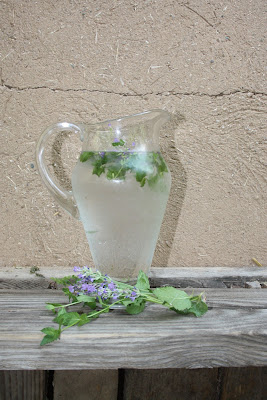Part of growing a good garden, naturally, is harvest - at time of strangest things, or things that sound good in theory but may be a bit hard to fit in an established routine of cooking and consuming familiar dishes. Cooking from a garden is a subject of its own, with lamb's quarters, garlic scapes, beet greens, cilantro flowers, Jerusalem artichoke roots, zucchini flowers, purslane, dandelion leaves, parsnip roots, day lily flowers and much more to please the palate and to challenge our under-developed capacity to eat new foods. Of course new foods don't stay new for long and soon become as familiar as a store-bought carrot.
Latest meal on the table was parsnips and baby beets sauteed with fresh onions, beet greens and leaves of lamb's quarters. Sprinkled with rice vinegar and sesame seeds, served with summer Sauer Kraut and meat patties, this was a splendid experience. As usual, a gardener (and particularly, a permaculture gardener) never ceases to enjoy meals (or dishes) made completely out of garden-provided bounty.
Eating fresh raw asparagus is a nice early spring treat to the senses. Blue borage flowers come from winter greenhouse, a lovely decor and a tasty addition. And avocados (store-bought) never hurt anything!
This is what is next on the harvest front - garlic, onions, lavender and more herbs for tea (raspberry leaves, alfalfa, red clover etc) - dried in the shade, stored for months to come. Lavender and onions don't seem to create a dish of any notable taste, but each has a lot to offer individually.
Iced water with fresh lavender blossom and crushed leaves of mint plant, oh how good it goes with the month of July and its heat and some inherent endlessness of futile efforts to keep up with weeds.... This drink punctuates the heat, brings some certainty that rains will come, they MUST come, and that the garden will perk up and grow and not just sit there patiently suffering the heat.
Those of us gardening soon realize that traditional dishes are not just a combination of things that taste well together. They are made of foods that occur at the same time and in the same place. Try making peach chutney if you are homesteading and don't have a supply of garlic or (even worse) fresh peaches. Garlic and peaches ripen at the same time (at least some varieties of peaches do, some come in after the garlic is cured but still plentiful).
Try making moussaka without ground lamb meat, or yogurt or eggplant. Baby lambs mean plentiful milk for making yogurt, and they also mean summer heat needed for yogurt to ripen, and flavorful garlic, eggplant, new tomatoes and peppers - time of bounty of all things cultivated.
Basil-tomato-mozzarella combo also arises from the bounty of the season, with plentiful summer milk to make fresh cheese, and sun-ripened herbs and fruit.
Arugula and beet salad, radish with greens - these meals from an earlier spring season repertoire also ripen at the same time. And so it goes, good things to eat telling us in their own way about how gardens grow and how animals live!








No comments:
Post a Comment